The document discusses Java networking concepts including sockets, TCP, UDP, client-server programming, and key networking classes like InetAddress, ServerSocket, Socket, DatagramSocket, and DatagramPacket. It provides code examples for basic TCP and UDP client-server applications in Java using sockets to demonstrate sending and receiving data over a network.
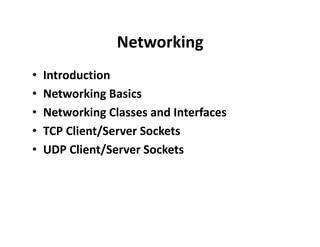

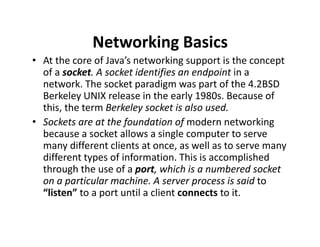




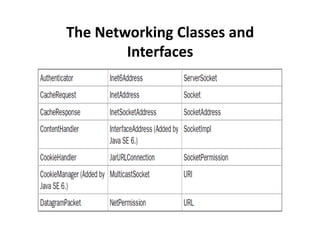
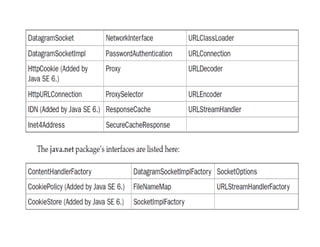
![• InetAddress: The InetAddress class is used to
encapsulate both the numerical IP address and the
domain name for that address.
// Demonstrate InetAddress.
import java.net.*;
class B
{
public static void main(String args[]) throws
UnknownHostException {
InetAddress Address = InetAddress.getLocalHost();
System.out.println(Address);
Address = InetAddress.getByName("google.com");
System.out.println(Address);
} }](https://image.slidesharecdn.com/28-networking-130815152800-phpapp02/85/28-networking-10-320.jpg)
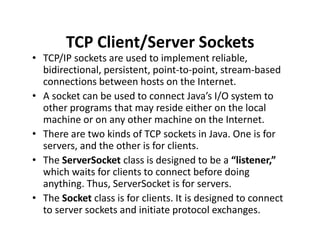
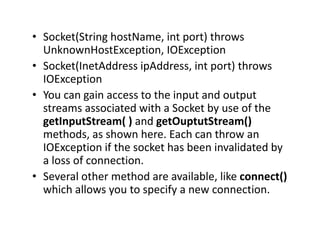
![• Simple TCP Server.
import java.io.*;
import java.net.*;
class TCPServer {
public static void main(String argv[]) throws Exception {
String clientSentence;
String capitalizedSentence;
ServerSocket welcomeSocket = new ServerSocket(6789);
while(true)
{ Socket connectionSocket = welcomeSocket.accept();
BufferedReader inFromClient = new BufferedReader(new
InputStreamReader(connectionSocket.getInputStream()));
DataOutputStream outToClient = new
DataOutputStream(connectionSocket.getOutputStream());
clientSentence = inFromClient.readLine();
System.out.println("Received: " + clientSentence);
capitalizedSentence = clientSentence.toUpperCase() + 'n';
outToClient.writeBytes(capitalizedSentence);
} } }](https://image.slidesharecdn.com/28-networking-130815152800-phpapp02/85/28-networking-13-320.jpg)
![• Simple TCP Client
import java.io.*;
import java.net.*;
class TCPClient {
public static void main(String argv[]) throws Exception {
String sentence, modifiedSentence;
BufferedReader inFromUser = new BufferedReader( new
InputStreamReader(System.in));
Socket clientSocket = new Socket("localhost", 6789);
DataOutputStream outToServer = new
DataOutputStream(clientSocket.getOutputStream());
BufferedReader inFromServer = new BufferedReader(
new InputStreamReader(clientSocket.getInputStream()));
sentence = inFromUser.readLine();
outToServer.writeBytes(sentence + 'n');
modifiedSentence = inFromServer.readLine();
System.out.println("FROM SERVER: " + modifiedSentence);
clientSocket.close(); } }](https://image.slidesharecdn.com/28-networking-130815152800-phpapp02/85/28-networking-14-320.jpg)
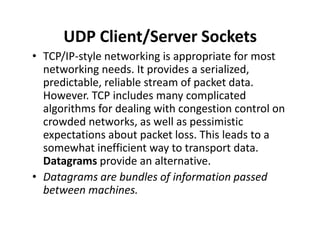

![DatagramSocket( ) throws SocketException
DatagramSocket(int port) throws SocketException
• DatagramSocket defines many methods. Two of
the most important are send( ) and receive()
void send(DatagramPacket packet) throws
IOException
void receive(DatagramPacket packet) throws
IOException
• DatagramPacket defines several constructors.
DatagramPacket(byte data[ ], int size)
DatagramPacket(byte data[ ], int offset, int size)](https://image.slidesharecdn.com/28-networking-130815152800-phpapp02/85/28-networking-17-320.jpg)
![• simple UDP server.
import java.io.*;
import java.net.*;
class UDPServer {
public static void main(String args[]) throws Exception {
DatagramSocket serverSocket = new DatagramSocket(9876);
byte[] receiveData = new byte[1024];
byte[] sendData = new byte[1024];
while(true) {
DatagramPacket receivePacket = new DatagramPacket(receiveData, receiveData.length);
serverSocket.receive(receivePacket);
String sentence = new String(receivePacket.getData(), 0, receivePacket.getLength());
System.out.println("RECEIVED: " + sentence);
InetAddress IPAddress = receivePacket.getAddress();
int port = receivePacket.getPort();
String capitalizedSentence = sentence.toUpperCase();
sendData = capitalizedSentence.getBytes();
DatagramPacket sendPacket = new DatagramPacket(sendData, sendData.length,
IPAddress, port);
serverSocket.send(sendPacket); } } }](https://image.slidesharecdn.com/28-networking-130815152800-phpapp02/85/28-networking-18-320.jpg)
![import java.io.*;
import java.net.*;
class UDPClient {
public static void main(String args[]) throws Exception {
BufferedReader inFromUser = new BufferedReader(new
InputStreamReader(System.in));
DatagramSocket clientSocket = new DatagramSocket();
InetAddress IPAddress = InetAddress.getByName("localhost");
byte[] sendData = new byte[1024];
byte[] receiveData = new byte[1024];
String sentence = inFromUser.readLine();
sendData = sentence.getBytes();
DatagramPacket sendPacket = new DatagramPacket(sendData,
sendData.length, IPAddress, 9876);
clientSocket.send(sendPacket);
DatagramPacket receivePacket = new DatagramPacket(receiveData,
receiveData.length);
clientSocket.receive(receivePacket);
String modifiedSentence = new String(receivePacket.getData());
System.out.println("FROM SERVER:" + modifiedSentence.trim());
clientSocket.close(); } }](https://image.slidesharecdn.com/28-networking-130815152800-phpapp02/85/28-networking-19-320.jpg)
